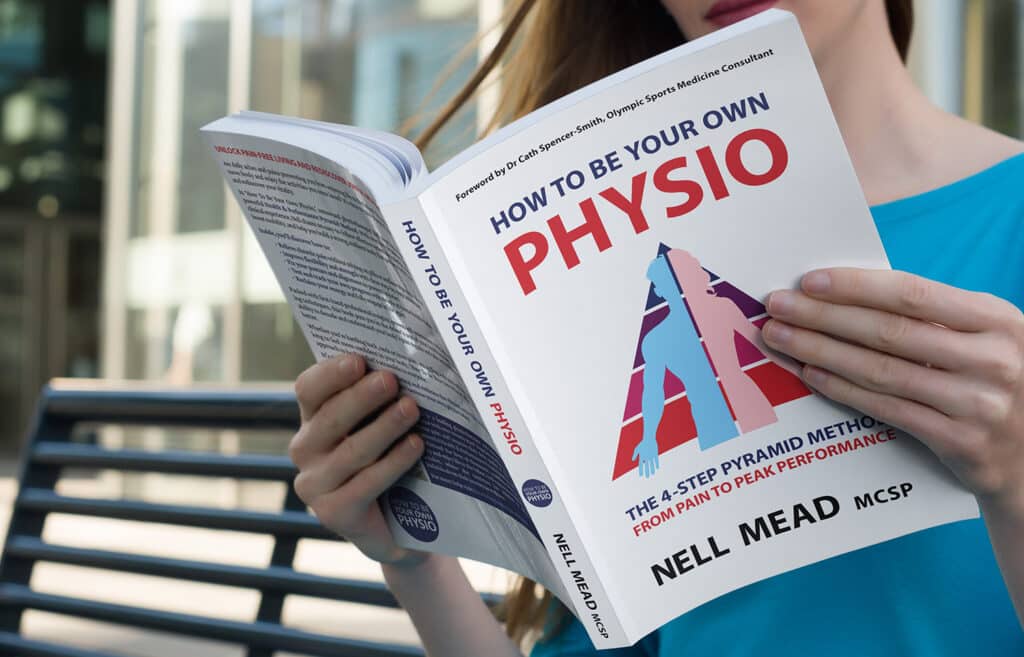The prequel…
Marketing director and keen athlete Russell came to see me in my physiotherapy clinic, complaining of pain and stiffness in his right hip. He was still able to run, but cycling was becoming difficult, and bending to put his socks on and cut his toenails was becoming very tricky! His GP had sent him for an X-ray which had confirmed a diagnosis of osteoarthritis, and thought that Russell might need a hip replacement; but Russell, at 56, felt too young for such a procedure and asked if there was anything else that could be done.
When I assessed Russell’s posture, it was clear that his biomechanics weren’t optimal. He wasn’t controlling his right hip very well as he loaded it. He had a distinct “forward head posture” (where the chin pokes forward) and this became more pronounced when he transferred his weight onto his right foot. When I encouraged him to lengthen his neck, he controlled his weight transfer much better, felt less discomfort in the right hip, and was better able to activate his glute muscles, which are some of the major controllers of the hip joint.
As we were able to improve his hip function and make his pain and stiffness more tolerable, I felt that we might be able to at least delay hip surgery. Russell was happy with this plan, and after working diligently on his posture, started to use his right hip more optimally, with more range of movement and less pain.
The return of the hip
However, two years later, he came back to see me. The pain and stiffness had started coming back, and this time it was not as responsive to altering his biomechanics. Previously, changing his neck posture had changed his hip symptoms, but this was no longer the case, and now the issue seemed to be originating directly from the hip joint. I sent him for an MRI scan, which confirmed that it was time for a hip replacement.
Russell does not have a medical background, and made two very common, if misguided, assumptions. Firstly, that all hip surgeons and hip replacements are the same, and secondly, that all he needed was a new hip and that he’d be back up and running again. It wasn’t until I started sending him details of specific hip surgeons and talking about pre- and post-operative rehabilitation that he even realised he might need more physiotherapy, or that there might be more than one possible operation to consider!
Hip replacements have improved dramatically in the past 20 years
Hip replacement surgery has made great strides over the past 20+ years since I watched my first hip replacement, as a physiotherapy student! Back then, all hip implants were the same shape, though they came in a few different sizes; and the planning was done with a plain X-ray. This has really changed!
Top London hip surgeon Homa Arshad explains:
“Total hip replacement is a highly successful operation for arthritis. People come in all shapes and sizes, and the goal of hip replacement surgery is to restore a patient’s ideal anatomy. The limited options of standard implants can sometimes affect the functional outcome as the shape, angle or direction is a compromise rather than a perfect fit. The best way of restoring a healthy walking pattern with good strength and function, is a custom-planned hip replacement. 3D scans are taken and used to plan the surgery. If someone’s bone shape is very unusual, they may need a special implant uniquely designed to fit them, and this can take a little longer – but getting the right shaped implant is the most reliable way of achieving an excellent result.”
Not all hip surgeons work with custom hip implants, but given that Russell wanted to be able to run comfortably after the surgery, we needed to ensure that his implant would be optimally shaped and positioned to cope – which wasn’t as likely to be the case with a traditional implant.
But it’s not all about the surgery!
Apart from the surgery, it also became obvious to me that Russell needed to move better. He had started to develop compensation patterns: movement habits that weren’t optimal and that weren’t going to help him recover from surgery. He was limping and avoiding taking weight on the right leg, and as a result, his muscles were getting weaker and less responsive.
So, while Russell’s custom implant was being made (which takes a few weeks), I got him working on a pre-operative rehabilitation (“prehab”) programme, to restore some of his muscle strength and flexibility, and to stimulate his nervous system so that he would be likely to make a faster and better recovery from the surgery.
I was very pleased that Russell’s surgeon was happy for me to observe the operation. I find this really useful, for a whole load of reasons that I’ve explained previously – essentially though, if I’m going to be spending the next few months helping you to recover, then the more information I have about what’s happened to you, the easier it is for me to give you the best possible help.
Immediately after the operation, Russell started his post-operative exercises, working on activating his muscles to restore his hip control. His recovery was actually quite dramatic, in that he was walking unaided within two days (!), able to start running just three months after the surgery, and he’s now back to running 10k regularly.
How does Russell feel about it all?
Well, this is Russell’s experience:
“The thing that surprised me after my right hip replacement was the complete loss of control I had over my glutes. I was able to activate my left glutes at will (although not very powerfully, according to Nell!) but couldn’t feel my right at all. I wasn’t actually very concerned about this, and assumed it would get back to normal by itself, until Nell reminded me that my goal was to get back to running as quickly as possible, and that I couldn’t do this until I could control my hip!
At the beginning, there was no sensation at all in my right glutes, and so Nell gave me a variety of exercises all aimed at “re-establishing the link between my brain and my glutes”. I found these incredibly difficult and frustrating at first, but eventually I was able to activate the right glutes independently of the left side, and I felt I was well on my way to being able to twerk again!
Consciously remembering to engage each glute as I walked was something I could initially only achieve when I put my hands on my glutes to feel them working – an odd look when walking, but even odder when I started running again! But I got there. I now have a little “glute routine” that I do before I go for a run, and I’m sure this has helped my running style. I’ve now realised that prior to the hip replacement, all my running power came from my calves – and these days I feel a lot more solid and controlled. It feels like an odd thing to say when one hip is made of metal, but my running actually feels more natural now than it did before I had the surgery!”
Let me help you!
Not all hip replacements are the same. Not all hip surgeons are the same. And not all physios are the same. There are no guarantees in this life. But if you get a great hip replacement, a great hip surgeon and a great physio, then your chances of making a great recovery are much higher! If you’d like to discuss a stiff, sore hip, or plan for a hip replacement, then please call my team on 0207 175 0150 and let’s get you booked in for an assessment.







